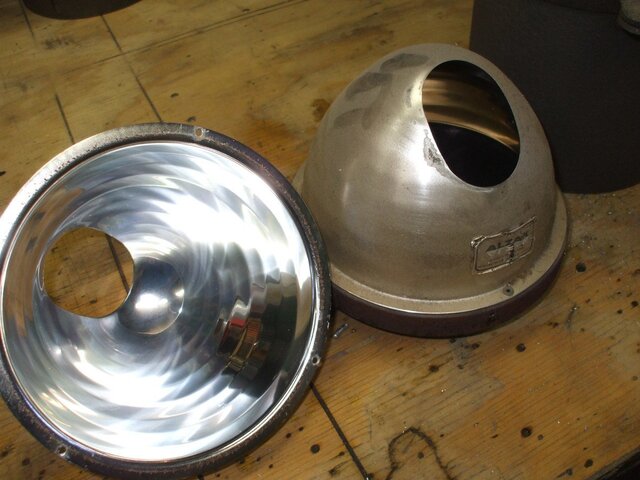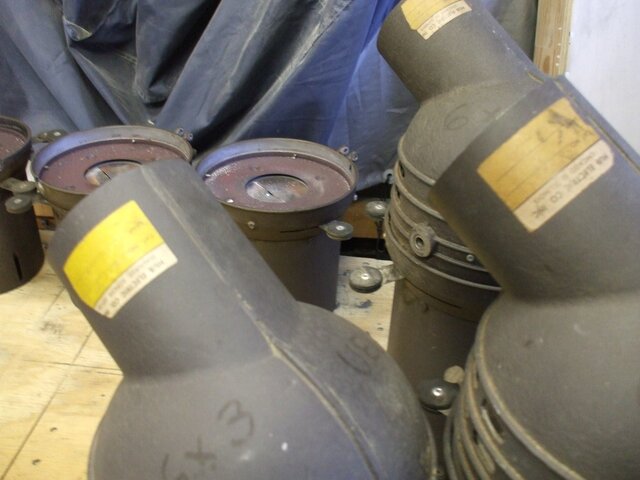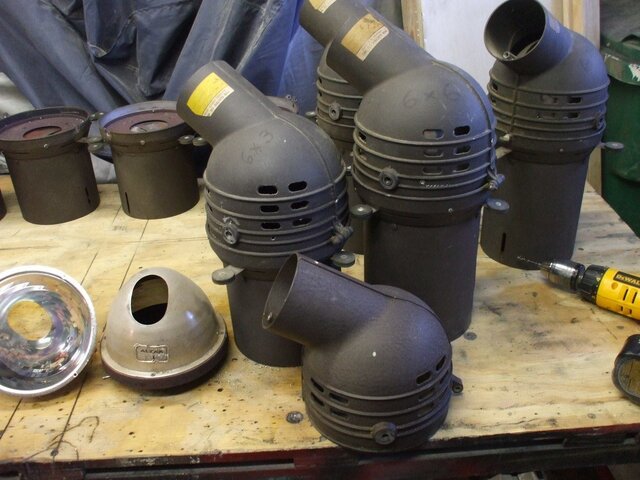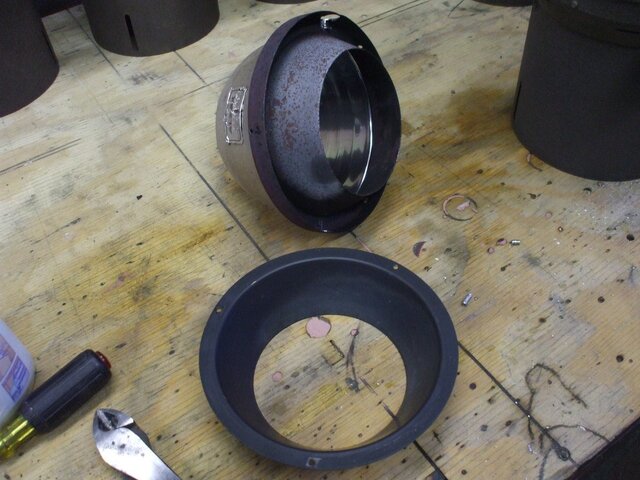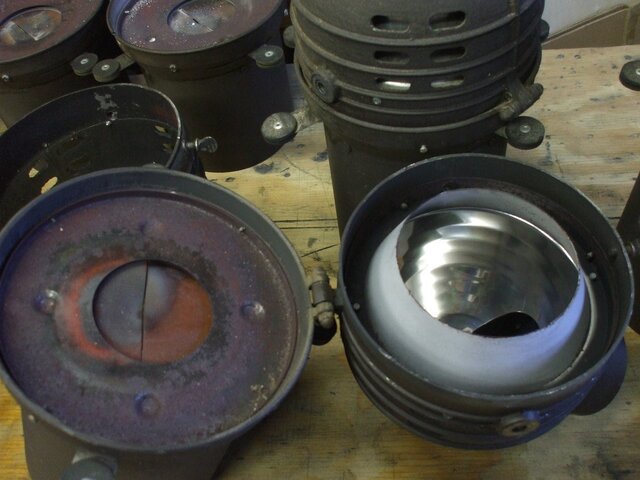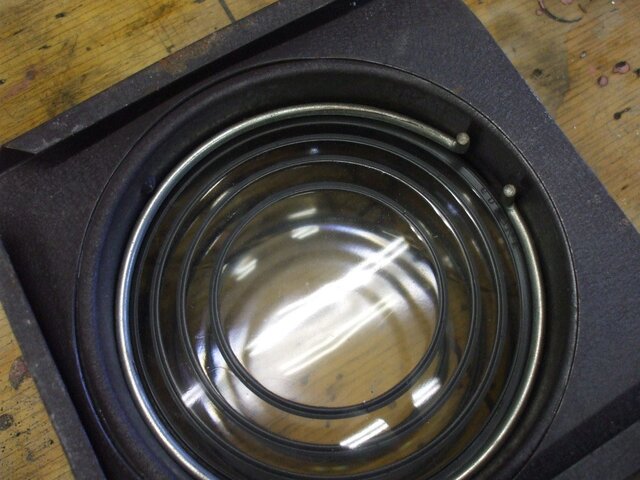Got in ten Texture Black radial Leko’s today plus a Century - later. Stickers say Hub Electric #8763 for the 6x12 and #8663 for the 6x9 radial Leko’s on the snout. No not in the Hub catalogue recently put on-line which lists or shows them thus perhaps post 1967 for age of them given the stickers.. (Looked at the catalogue thoroughly and I didn’t see any Altman style 360 fixtures in it at least.)
Seem just like an Altman 360 series Leko in what I would call but cannot be confirm as the 1957-62 era for Altman before they went Hammertone Brown. (I know by 62' Altman was the Hammertone Brown.) Was that third color in existence as an Altman color or was this another brand either Hub or Hub bought from - say Century in what year did they go out of business I don’t remember? (This assuming Altman and Century had similar fixtures on the market at the same time.) I know Hub mostly bought from other makers than Altman - see the Strand PAR can, the Kliegl and Century other fixtures from Colortran etc. listed in the catalogue, but specifically no Altman. Did Hub make their own gear? Was that gear they made - designs and even say tooling from others perhaps later made by them after others advanced to something else? Old other brand castings say? (Got a lot of fixtures dependant on age and brand that I think are early Altman but perhaps in riding on this question - was it the exact similar design but different paint thru say Hub or Century and later?) Was Hammertone Brown the first color for Altman or was it Texture Black?
Guy I’m working with from a community theater remembers the Hub #8765 well from high school - like thirty to forty years ago in a light that will have been similar in age. Given that Leko in the Hub catalogue is seemingly Century in appearance, was he working with the first and real 1936 “Leko”? Or was the Hub fixture similar to but different than it - this in still being sold into the early 60's by way of Hub? Did Hub perhaps buy the design and continue making them otherwise? I have the 8764 which is a #1865E 1950 Kliegl, and the #8768 which also has Century knobs thus I believe an un-known 1939 Century design, though I'm yet to find conformation on it. Hub was clealy retailing other makers gear and placing their sticker on them.
Think Hub mostly retailed other brands of fixture and later perhaps sold the Altman line. Still though there is a problem with that concept. If I have fixtures that are Texture Black that if I date to 57' thru 62, why didn’t this Hub catalogue from the era in up to 67' list any Altman like fixtures? Clearly a Hub fixture in sticker on it I recieved today, yet not listed in even in the 67' catalogue for this I will have thought pre-1962 era fixture. Indication of such a fixture later for ceiling mount types of similar drawing, but no pipe mount type of Altman 360 style listed. Hub catalogue lists nothing similar to these I have in my garage to work on. Yet they should be a much older version than listed given the color and style.
The heck was Hub doing in screwing up anything history time line I thought? Listing even I think 1936 and 1939 Lekos even into the 60's. Anyone of help here? (Granted the S-4 is almost as venerable at this point for the most base of concept. Still something from 36' listed in even a 62 era catalogue as optimum given all the advances over the years... hard to figure out given the Hub catalogue.)
Also of note on the few Lekos I got that were easily opened (rest stuck somewhat) was that all gate reflectors were aluminum as opposed to steel as often found on similar aged fixtures. Given either blackened or reflective but very dusty gate reflector - not something normal to an Altman 360 line. Half were blackened on the reflector in not reflecting - but still aluminum, the other half while dirty, were a reflecting source. Completely a later than say 62' concept I think the gate reflector. This much less I was expecting more steel gate baffle than aluminum ones reflective or blackened given the texture paint era. Possible small detail but what I found in two and many more eras perhaps. Still are these Altman making the fixtures and from steel to aluminum blackened in to reflective between 57-62" Doubtful so much change. This especially if a Hub sticker on the fixture with one or two ways of doing gate reflectors... Yet Hub up until 67' doesn’t even advertise a similar fixture they sell. Very confusing.
Further in curious is the raidal 6x9 step lens fixtures the theater still has. They are Texture Black and have a 360 shape to them but no band labels. Not marked from Hub but probably part of the same lot of fixtures bought from them in lots of interesting gear. Kopp glass which is possible for lens brand on the step lens. Dual step lens though... never seen that before and unless if say Altman 360 series originally had step lenses, I would think not accurate for the lens train & replacement lenses by a mis-guided person. A couple of them though in that being a problem for that concept. Certanly the parent company Century as it were, was beyond step lenses and now dual lenses by now for similar Leko’s. What are these 6x9 Leko’s doing with dual lens step lenses? Accurate and a new concept in the radial Leko nobody has seen yet - or someone over the years putting in something that would fit? Same in all other ways to this early 360 class other than the lens. (Yet to bench focus them and will soon.) Still though... dual step lens 360 like lens train? By now the lens train with normal lenses was well established. This verses say single lens Kliegl holdovers from the 50's installed by armature tech person to replace say broken lenses. I think in not jumping on the examples for the museum so far but very curious that I am very curious about this double step lens concept for what otherwise would be a normal first era 360 series Leko. Given this... Perhaps Hub was making their own Leko’s as a concept.
Separate totally...
Also got in a Century 6x9 Leko today. Believe it to be their last version of Leko before they went out of business. Now think I have all styles of them except the first version above mentioned this TD learned with and remembers. One problem is the paint job on this 4.5x6x5 style I now own one of. The lens train is what I would think more of the Century Hammertone Gray color. The rest is more of a Hammertone Olive Drab in color. Interesting this different color, yet the last era I think. Possible back in the day someone did some base/lens train swapping? Like six of them in stock in the theater without other fixtures of that brand. All are similar in that lens train swapping concept.
Gray tone Century I think earlier than the more beige versions of later. On these fixtures, dependant on what section of them you look at, the more the color changes as per a factory type of thing. Was Century re-painting stuff and or just these the last era of their Leko’s by way of painting and tapering? Lamp cap to pineapple, to gate assembly to snout... all various assemblies are similar and tapering in factory color but not the same overall. It’s as if the last generation in painting what was needed and yea.. Paint good towards the end. Can see tapered paint on some parts for not bothering to cover. Blend I think of 50's Gray paint color and later Olive Drab.
Whats’ going on with this I think last generation of Century Leko? Accurate that they do from Olive Drab to Gray or something really unusual? Note the pineapple assembly of Olive drab peeled off sufficiently that I needed to remove it. Not as high temp. as one might expect.
History of lighting help here?
Seem just like an Altman 360 series Leko in what I would call but cannot be confirm as the 1957-62 era for Altman before they went Hammertone Brown. (I know by 62' Altman was the Hammertone Brown.) Was that third color in existence as an Altman color or was this another brand either Hub or Hub bought from - say Century in what year did they go out of business I don’t remember? (This assuming Altman and Century had similar fixtures on the market at the same time.) I know Hub mostly bought from other makers than Altman - see the Strand PAR can, the Kliegl and Century other fixtures from Colortran etc. listed in the catalogue, but specifically no Altman. Did Hub make their own gear? Was that gear they made - designs and even say tooling from others perhaps later made by them after others advanced to something else? Old other brand castings say? (Got a lot of fixtures dependant on age and brand that I think are early Altman but perhaps in riding on this question - was it the exact similar design but different paint thru say Hub or Century and later?) Was Hammertone Brown the first color for Altman or was it Texture Black?
Guy I’m working with from a community theater remembers the Hub #8765 well from high school - like thirty to forty years ago in a light that will have been similar in age. Given that Leko in the Hub catalogue is seemingly Century in appearance, was he working with the first and real 1936 “Leko”? Or was the Hub fixture similar to but different than it - this in still being sold into the early 60's by way of Hub? Did Hub perhaps buy the design and continue making them otherwise? I have the 8764 which is a #1865E 1950 Kliegl, and the #8768 which also has Century knobs thus I believe an un-known 1939 Century design, though I'm yet to find conformation on it. Hub was clealy retailing other makers gear and placing their sticker on them.
Think Hub mostly retailed other brands of fixture and later perhaps sold the Altman line. Still though there is a problem with that concept. If I have fixtures that are Texture Black that if I date to 57' thru 62, why didn’t this Hub catalogue from the era in up to 67' list any Altman like fixtures? Clearly a Hub fixture in sticker on it I recieved today, yet not listed in even in the 67' catalogue for this I will have thought pre-1962 era fixture. Indication of such a fixture later for ceiling mount types of similar drawing, but no pipe mount type of Altman 360 style listed. Hub catalogue lists nothing similar to these I have in my garage to work on. Yet they should be a much older version than listed given the color and style.
The heck was Hub doing in screwing up anything history time line I thought? Listing even I think 1936 and 1939 Lekos even into the 60's. Anyone of help here? (Granted the S-4 is almost as venerable at this point for the most base of concept. Still something from 36' listed in even a 62 era catalogue as optimum given all the advances over the years... hard to figure out given the Hub catalogue.)
Also of note on the few Lekos I got that were easily opened (rest stuck somewhat) was that all gate reflectors were aluminum as opposed to steel as often found on similar aged fixtures. Given either blackened or reflective but very dusty gate reflector - not something normal to an Altman 360 line. Half were blackened on the reflector in not reflecting - but still aluminum, the other half while dirty, were a reflecting source. Completely a later than say 62' concept I think the gate reflector. This much less I was expecting more steel gate baffle than aluminum ones reflective or blackened given the texture paint era. Possible small detail but what I found in two and many more eras perhaps. Still are these Altman making the fixtures and from steel to aluminum blackened in to reflective between 57-62" Doubtful so much change. This especially if a Hub sticker on the fixture with one or two ways of doing gate reflectors... Yet Hub up until 67' doesn’t even advertise a similar fixture they sell. Very confusing.
Further in curious is the raidal 6x9 step lens fixtures the theater still has. They are Texture Black and have a 360 shape to them but no band labels. Not marked from Hub but probably part of the same lot of fixtures bought from them in lots of interesting gear. Kopp glass which is possible for lens brand on the step lens. Dual step lens though... never seen that before and unless if say Altman 360 series originally had step lenses, I would think not accurate for the lens train & replacement lenses by a mis-guided person. A couple of them though in that being a problem for that concept. Certanly the parent company Century as it were, was beyond step lenses and now dual lenses by now for similar Leko’s. What are these 6x9 Leko’s doing with dual lens step lenses? Accurate and a new concept in the radial Leko nobody has seen yet - or someone over the years putting in something that would fit? Same in all other ways to this early 360 class other than the lens. (Yet to bench focus them and will soon.) Still though... dual step lens 360 like lens train? By now the lens train with normal lenses was well established. This verses say single lens Kliegl holdovers from the 50's installed by armature tech person to replace say broken lenses. I think in not jumping on the examples for the museum so far but very curious that I am very curious about this double step lens concept for what otherwise would be a normal first era 360 series Leko. Given this... Perhaps Hub was making their own Leko’s as a concept.
Separate totally...
Also got in a Century 6x9 Leko today. Believe it to be their last version of Leko before they went out of business. Now think I have all styles of them except the first version above mentioned this TD learned with and remembers. One problem is the paint job on this 4.5x6x5 style I now own one of. The lens train is what I would think more of the Century Hammertone Gray color. The rest is more of a Hammertone Olive Drab in color. Interesting this different color, yet the last era I think. Possible back in the day someone did some base/lens train swapping? Like six of them in stock in the theater without other fixtures of that brand. All are similar in that lens train swapping concept.
Gray tone Century I think earlier than the more beige versions of later. On these fixtures, dependant on what section of them you look at, the more the color changes as per a factory type of thing. Was Century re-painting stuff and or just these the last era of their Leko’s by way of painting and tapering? Lamp cap to pineapple, to gate assembly to snout... all various assemblies are similar and tapering in factory color but not the same overall. It’s as if the last generation in painting what was needed and yea.. Paint good towards the end. Can see tapered paint on some parts for not bothering to cover. Blend I think of 50's Gray paint color and later Olive Drab.
Whats’ going on with this I think last generation of Century Leko? Accurate that they do from Olive Drab to Gray or something really unusual? Note the pineapple assembly of Olive drab peeled off sufficiently that I needed to remove it. Not as high temp. as one might expect.
History of lighting help here?
Last edited:



